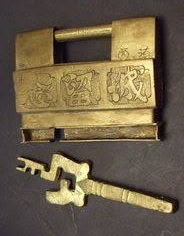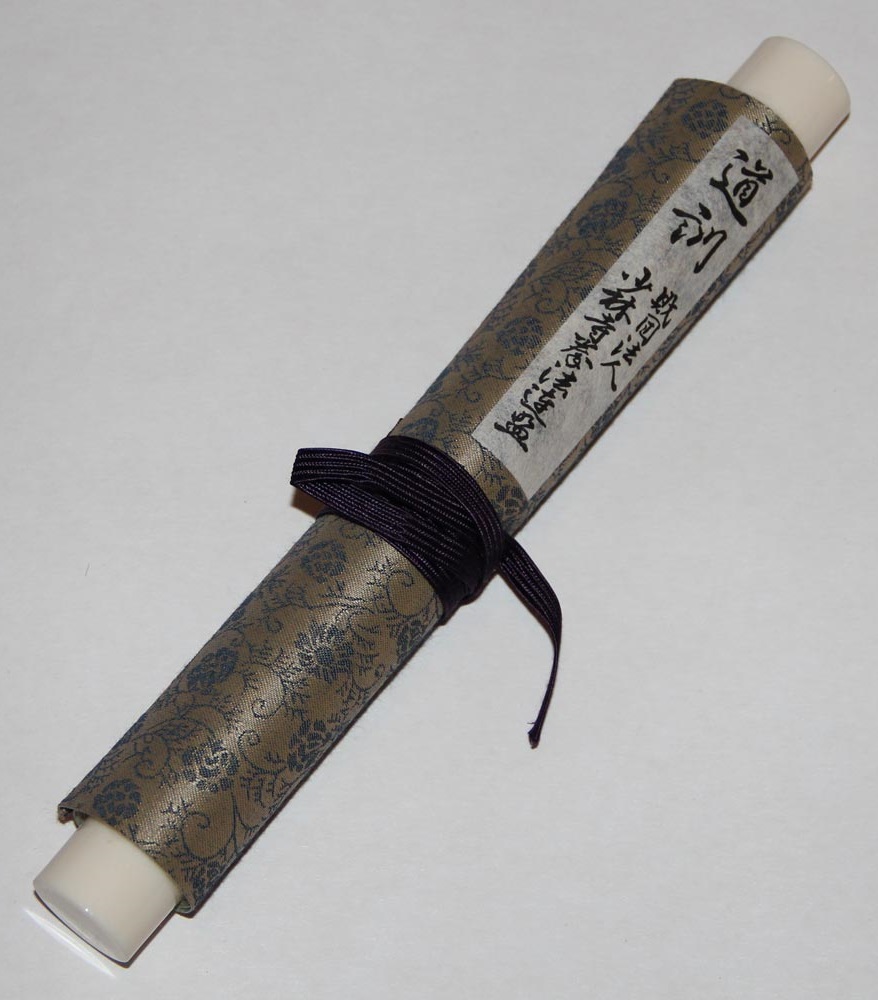Jitte Description
After bowing and announcing the name of the kata ("Jitte") ...
Yōi (cross open hands at groin level in
musubi dachi) and kiyomeri kokyū
(purification breaths)
Draw feet into heisoku dachi
while hands perform kote mawashi
at chest level
| 1 | Step back with left foot into migi sanchin dachi with migi sode-garami uke ("sleeve-tangling block") | |
| 2 | Step forward into hidari sanchin dachi with migi osae uke and hidari age zuki | |
| 3 | Hidari osae uke, then step right with right foot into shiko dachi with yoko ura-shutō uchi and kiai | |
| 4 | Pivot 90 degrees to the left whilst stepping forward with the right foot into shiko dachi with migi sukui uke | |
| 5 | Step forward with the left foot, turning 180 degrees to the left into shiko dachi with hidari sukui uke | |
| 6 | Step forward with the right foot, turning 180 degrees to the right into shiko dachi with migi sukui uke | |
| 7 | Draw right foot leftward into migi kōsa dachi with morote yoko uke and morote gedan barai | |
| 8 | Step left with the left foot into shiko dachi with yama uke | |
| 9 | Turning 180 degrees left, step to the right into shiko dachi with yama uke | |
| 10 | Turning 180 degrees left, step to the right into shiko dachi with yama uke | |
| 11 | Turning 180 degrees left, step to the right into shiko dachi with yama uke | |
| 12 | Draw right foot inward into heiko dachi with morote gedan barai | |
| 13 | Pivot on left foot 90 degrees to the right into neko-ashi dachi with migi shuto uke (with closed-fist hikite) | |
| 14 | Slide right foot forward into migi han-zenkutsu dachi with hidari-te ue morote shōtei uchi | |
| 15 | Step forward into hidari han-zenkutsu dachi with migi-te ue morote shōtei uchi | |
| 16 | Steo forward into migi han-zenkutsu dachi with hidari-te ue morote shōtei uchi | |
| 17 | Turn 270 degrees left into hidari kōkutsu dachi with manji uke | |
| 18 | Shift 180 degrees right into migi kōkutsu dachi with manji uke | |
| 19 | Step 90 degrees left into hidari zenkutsu dachi with hidari age uke | |
| 20 | Step forward into migi zenkutsu dachi with migi wantō uchi | |
| 21 | Turn 180 degrees left into hidari zenkutsu dachi with hidari age uke | |
| 22 | Step forward into migi zenkutsu dachi with migi wantō uchi |
Zanshin yame by turning 180 degrees left whilst drawing
left foot into heisoku dachi and
performing kote mawashi at
chest level
Naotte
Rei


 As
with each new kata, it is important to remind
oneself of the adage: "Manabu no tame ni hyakkkai,
jukuren no tame ni senkai, satori no tame ni manga
okonau" (学ぶのために百回、熟練のために千回、悟りのために万回行う.).
A hundred times to learn, a thousand
times for proficiency, ten thousand
repetitions for complete understanding.
A related Okinawan saying is "ichi kata san nen"
(一型三年): one kata
three years. To become truly proficient-to be able to perform it
correctly, and with the speed, power, timing, and bushi damashii (samurai spirit) necessary
to make its techniques effective in a real self-defence
situation will take a thousand repetitions, which
equates to 100 days at ten repetitions a day.
And to fully understand and apply all of its principles,
nuances, and variations will take 1,000 days (three
years) at ten repetitions per day.
As
with each new kata, it is important to remind
oneself of the adage: "Manabu no tame ni hyakkkai,
jukuren no tame ni senkai, satori no tame ni manga
okonau" (学ぶのために百回、熟練のために千回、悟りのために万回行う.).
A hundred times to learn, a thousand
times for proficiency, ten thousand
repetitions for complete understanding.
A related Okinawan saying is "ichi kata san nen"
(一型三年): one kata
three years. To become truly proficient-to be able to perform it
correctly, and with the speed, power, timing, and bushi damashii (samurai spirit) necessary
to make its techniques effective in a real self-defence
situation will take a thousand repetitions, which
equates to 100 days at ten repetitions a day.
And to fully understand and apply all of its principles,
nuances, and variations will take 1,000 days (three
years) at ten repetitions per day.